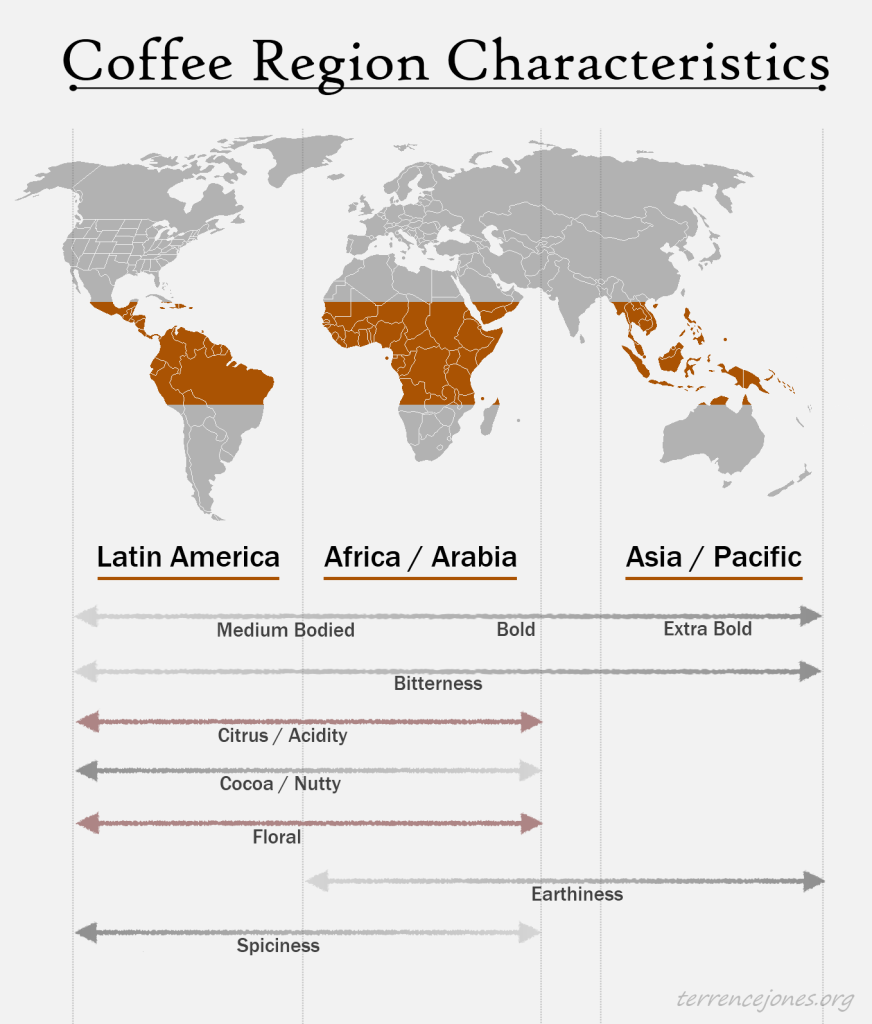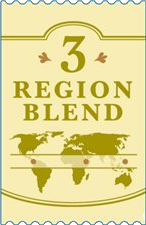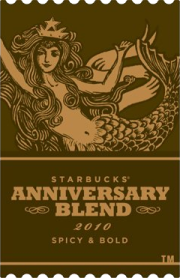Coffee Flavor and Tastes by Country and Region
or... Coffee for You, Coffee for Me
The Coffee
We all know we have a surfeit of coffee shops in any town large enough support a stop light. There, we see coffee from around the world; places like Sumatra, Columbia, Kenya, Ethiopia, Guatemala… What do coffees from these regions taste like?
Like wine, the coffee produced in these varied locations all have their unique characteristics. The coffee producing countries are commonly organized into three large regions: Latin America, Africa / Arabia, and Asia / Pacific. Among these regions are some characteristics that are shared and others that are unique to each. Here I try to give a generalized breakdown of these characteristics.
The Character
If you're like me, you might like your coffee neat—straight up—you know, black. When black the coffee's smell (nose), taste (palate), and feeling (body) are very recognizable. Just like with wine, careful attention paid to your coffee reveals subtlety and for me, enhances the drink incredibly.
Again like wine there are common tasting terms used to describe coffee. Though, compared with wine there are many fewer terms commonly associated with coffee.
When tasting coffee I immediately try to notice what I consider the three major components: boldness, bitterness and acidity. These traits make up the overall character of the coffee and are by far the most noticeable.
Here I attempt to organize these characteristics by region. Of course this is a high-level generalization:

More subtle and easily lost with the addition of sugar and milk are the secondary characteristics, the smells/tastes: floral, chocolate, nuttiness, earthiness, and spiciness. For me, these are all primarily recognized by the nose and except for a floral scent can generally be tasted as well.
The above picture gives a rough idea of what typical flavors and characteristics can be expected from the different regions. Generally we see more medium bodied coffees with citrus notes coming from Latin America. The richest, boldest, earthiest coffees tend to come from Asia / Pacific, Sumatra in particular. I'm a big fan of those coffee's from Sumatra.
I find Africa to be full of surprises. I like to think of the region as a real middle ground between Latin America and Asia / Pacific. It's not uncommon to find bold, bitter coffees coming from Kenya for example but often you'll find a balance of acid and citrus as well.
The Tastes
People often think of bad coffee being acidic or sour; but that's usually the result of cheap coffee that is poorly brewed. Acidic coffee can actually be incredibly refreshing and juicy. A bit of acid will make your mouth water literally! It's very common with good coffee to have beautiful citrus scents and flavors associated with acid. Similarly bitterness and bad coffee are often though to fit hand in glove. Consider however a good Indonesian coffee for example where the bitter character is well balanced with a deep rich earthiness.
 Earthiness itself can be thought of as literally an earth-soil like smell and taste. Think soil, peat, rocks and ash (in a good way!). Floral and chocolate are pretty straightforward for most people. Spice is a pretty broad term. In coffee you see everything from earth-spices like pepper, clove, and nutmeg to light notes such as basil, ginger and mint/eucalyptus. Fantastic…
Earthiness itself can be thought of as literally an earth-soil like smell and taste. Think soil, peat, rocks and ash (in a good way!). Floral and chocolate are pretty straightforward for most people. Spice is a pretty broad term. In coffee you see everything from earth-spices like pepper, clove, and nutmeg to light notes such as basil, ginger and mint/eucalyptus. Fantastic…
The Blend
Of course coffee is often (usually?) blended. The idea being to combine characteristics of various coffees to create a well balanced and complex blend of flavor and body.

Furthermore the handling and preparation of the coffee can change its character significantly.
The roast most obviously but the processing technique and even aging affect the final character. For a great example of aged coffee, see Starbucks' current 2010 Anniversary Blend; five years of aging in burlap sacks gives these Sumatra beans some great toasted spice flavors and a astounding amount of complexity.
What do you think? Hit the comments and tell us what you taste in your coffee!



 October 28, 2010
October 28, 2010 

















.jpg&w=50&h=50&zc=1&q=90)
